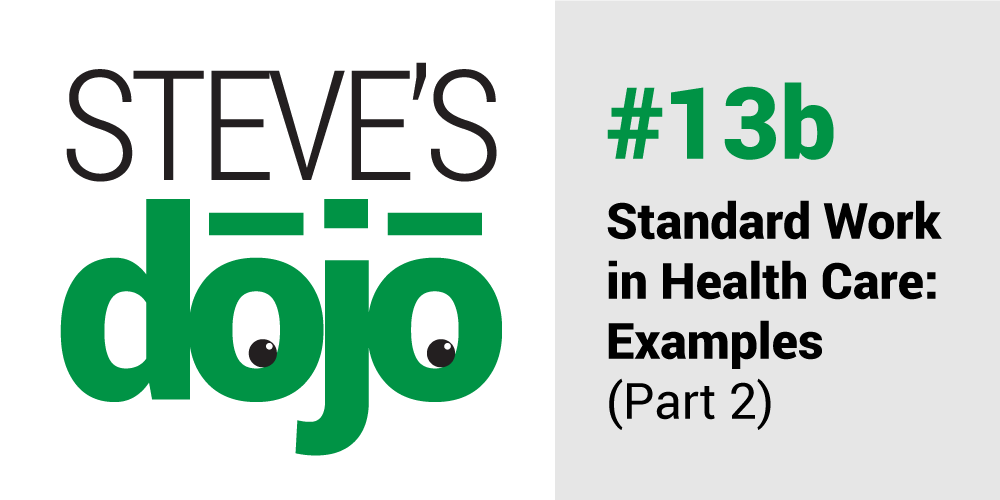Missed the last post?
Click here to read Standard Work (Part 1)
irav Shah, SVP at Kaiser Permanente; Southern California Region said, “Standardization is innovation.” It’s eloquent, insightful, and true.
Manufacturing organizations which benefit the most from standardization have standard work ingrained in the culture. Along with forcing functions, ubiquitous visual management, and rapid PDSA cycles, standard work helps process owners get it right.
Health care is on our way to such a culture. For instance, where manufacturing has a heijunka box, we have clinic templates in the EMR to smooth our production (i.e. clinic visits). Where they have standard work forms to track work in progress, we have patient tracking systems.
But we’re still very light on true standard work. For easy reference, here’re the core requirements. It ain’t legit standard work unless:
- It represents the best practice, minimizing variability and preventing errors
- The sequence of steps is included (target turnaround times help but aren’t required)
- It includes appropriate visuals
- It is thoughtful on word count, white space, and layout
- It is visual
- It is integrated into the flow of the work, always accessible, literally in an instant
Development of this standard work to scan a bladder was led by Jamie D’Ausilio. It was actually developed by the nurses and HCAs who do the job and today it is attached to their scanners on their inpatient unit.
Coming soon to an ICU near you: central line dressing change kit with packaging that acts as a forcing function. Recall that a forcing function is an upgrade from standard work. However, if this special packaging (the result of a scientific human factors analysis) wasn’t available, we would’ve made use of this central line dressing change standard work.
Value Engineering, System Quality, and Decision Support use standard work in some of our processes. They’re not much more than process maps but they meet the requirements. As another example, we have ICU ventilator standard work attached to the vent machines, developed by and for ICU residents.
But we still have a LONG way to go. For example, we’ve witnessed conscientious nurses and residents accessing clinical protocols, in paper form, filed in a three-ring, kept at the nurses’ station. This is the right thing to do and very encouraging. We want to help these clinicians keep doing it, but look at the barriers we placed between them and the right thing.
To access the protocols they had to leave the bedside, search for the right book, hope that no one had wandered off with it, flip to the right page, and then operate on faith that the paper form of the information was up to date. This situation fails the last two requirements (• visual • integrated, always accessible), so I can’t call it standard work with my hand on my heart.
We can do better.
But before we rush to a solution, let’s ask what’s great about a three-ring binder? 1) You don’t have to log in. 2) It’s easy to navigate; just flip the pages. Can we have the best of both?
Imagine a 22” touchscreen on the wall in the patient room with all pertinent protocols accessible with a single finger, always available, always up to date. There are no technical or security barriers to this scenario. McDonalds already has touchscreens taking their customer orders; it’s no longer a technology miracle. (Now, the Sausage Egg & Cheese McGriddle (550 calories)... that’s a culinary miracle of the highest order. On this there can be no debate.)
A system like this would be an example of technology leading the culture. It would be delivering genuine standard work to our workforce before they were using the phrase. But the real innovation would be the easier path to doing the right thing.
Steve Johnson
If in previous dojo posts, you still haven’t found what you’re looking for, today’s post will satisfy your desire. In it we describe the mysterious ways of Drs. Chris Hull’s and Mark Eliason’s clinic practice. Unless you’re a patient, you can’t witness their clinic, but this post is even better than the real thing.
Standard work is a visual guide to accomplish a job quickly and accurately. We asked our resident etiquette expert, Patient Advisor Mary Martha Tripeny, to put this Lean tool to the test by creating standard work for thank you notes. The holidays are stressful enough. This year, when nagging your children to write thank you notes, give Mary Martha’s standard work a try.
Hospitalist Ryan Murphy introduces quality improvement (QI): The systematic and continuous approach to improvement.
